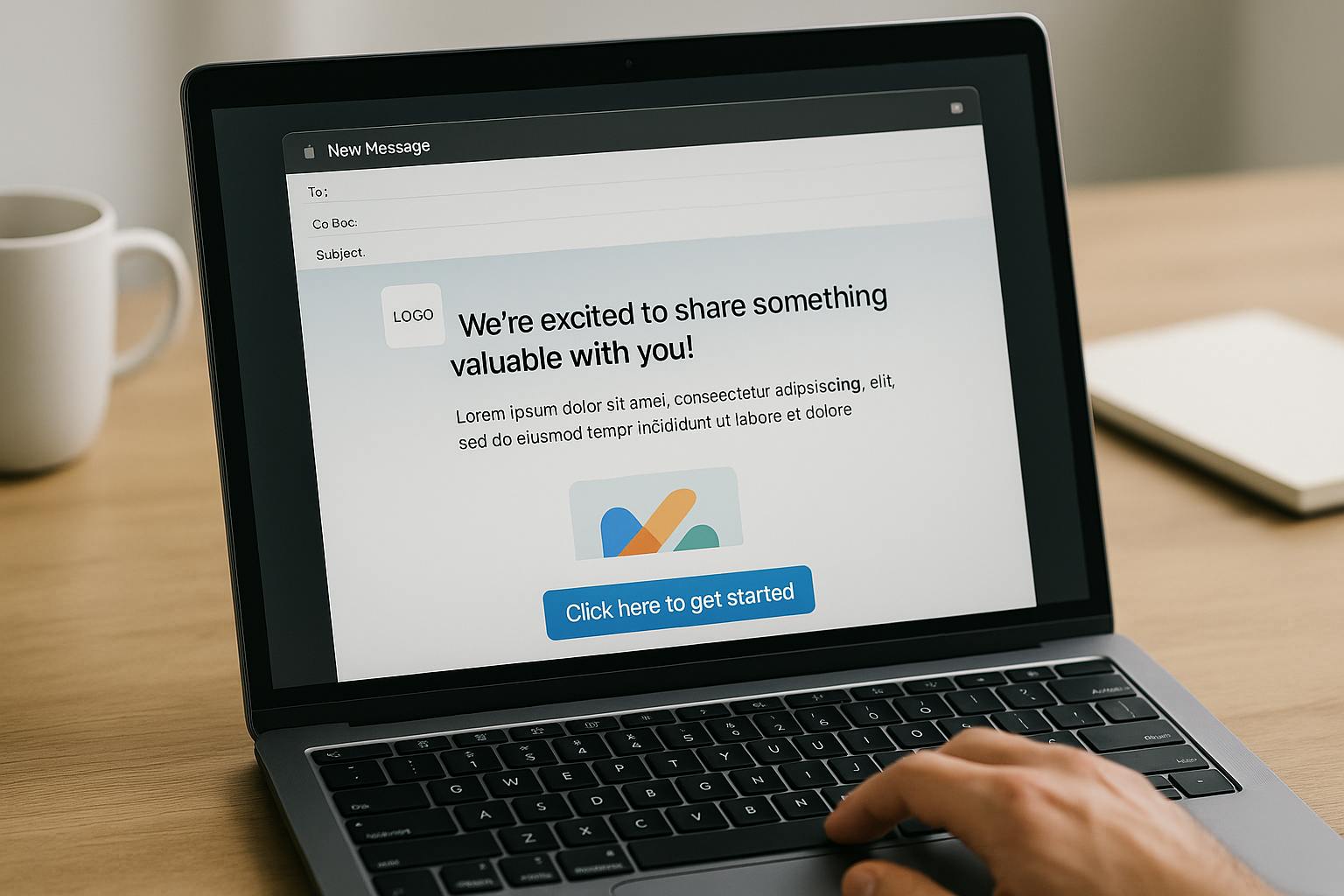
The Art of Email Copywriting!
August 22, 2025
Why Email Communication and Copywriting Matter
On any given morning, most of us glance through our Gmail inbox and instinctively decide what’s worth opening and what isn’t. One email pulls us in immediately, leading us to a landing page or even prompting the desired action. Another sits unopened, quickly forgotten.
The difference often comes down to just a few well-chosen words; a well-crafted email message can make all the difference in capturing attention and driving engagement.
But what if you had a tool that could help you understand why some emails succeed and others fail? This is where an Email Audit Engine comes into play, offering a data-driven approach to perfecting your copy.
Understanding Your Audience and Defining Goals
Every piece of email correspondence starts with the target audience. Knowing your readers' preferred language, challenges, and expectations, including their pain points, guides everything from subject line to sign off.
Clear goals ensure professional email communication aligns with your desired outcome, whether that’s nurturing a new client, boosting conversion rates, or driving traffic to landing pages.
Without clarity, writing emails risks becoming just another missed opportunity in crowded email inboxes.
Crafting an Irresistible Subject Line
The subject line is the gateway to effective email communication. Think of it as the headline of professional emails: it must spark curiosity, highlight benefits, or establish urgency. Practical tips for writing email subject line hooks include:
- Ask curiosity-driven questions.
- Keep formats concise and free from grammatical errors or spelling errors.
- Personalize using a company name or specific details.
- Create urgency but maintain professional email etiquette.
An engaging subject line can turn cold emails into opportunities with potential customers and ensure your message doesn’t get lost in formal communications.
Personalization, Segmentation, and Relevance
Nobody wants to feel like just another carbon copy recipient. Adding a personal touch, whether referencing a past interaction, tailoring email content to a segment, or adjusting email settings to match user preferences, makes each email unique.
When we personalize professional communication, we save time by making each generated email feel direct and authentic. This fine-tune approach ensures the email resonates with a broader range of readers.
Structuring Email Copy: Opening, Body, and Closing
Professional email etiquette demands a logical sequence. Structure is one of the key elements that helps readers navigate writing copy with ease:
- Opening: Grab attention with empathy, insight, or social proof.
- Body Copy: Share value, highlight the benefits of your product or service, and stay focused on key points.
- Closing: End with a persuasive call-to-action and clear sign-off.
Well-written emails that follow this structure ensure clarity and professionalism, making your communication more effective.
Writing professional emails in this structure makes email formats user-friendly and helps audiences grasp the main point quickly without distraction.
Tone, Brand Voice, and Clarity
Tone sets the mood of your professional communication. Whether formal tone or casual, consistency matters. Maintaining brand voice across marketing emails helps communicate effectively and avoid missed opportunities.
Clear, conversational body copy is key. Avoid overly technical writing in emails that lose readers. Short paragraphs and bullet points keep things readable on mobile devices.
Storytelling to Make Emails Engaging
Storytelling elevates writing professional emails into engaging narratives. A customer success story, a challenge faced by a new client, or even internal email anecdotes, especially when sharing real-life examples, show your product or service in action.
Specific details make professional business emails relatable, while storytelling strengthens the value proposition, connecting your company name with the unique communication your audience seeks.
Emotional Triggers and Persuasive Language
Emotion powers effective copywriting. Techniques like social proof, urgency, and highlighting benefits influence potential customers to take the desired action.
Whether writing copy for promotional email sequences or cold emails, emotional triggers work best when supported by other elements like logical sequence, professional tone, and clear CTAs.
These persuasive layers ensure professional emails reach the desired outcome: to drive conversions.
Clear and Compelling Calls-to-Action (CTAs)
CTAs are key components in email communication. To make them effective:
- Communicate the desired action with clarity.
- Highlight benefits and explain the value proposition.
- Use language that encourages immediate action, such as including time-sensitive words like "Now," "Today," or "Limited Time" to create urgency.
- Make it stand out visually with formats suited for mobile devices.
- Stick to one main point; too many CTAs create confusion.
A well-crafted CTA turns generated email into effective copywriting that saves time and achieves business goals.
Formatting for Readability

Formatting makes writing emails feel approachable. Good email etiquette means making it easy to read:
- Short paragraphs work better than long walls of text.
- Bullet points highlight key elements or key points.
- Whitespace improves readability across email clients and mobile devices.
- Professional email settings should support accessibility and clear display.
Readability is a free tool in itself; it turns professional communication into user-friendly, effective copywriting.
Using AI in Email Copywriting
AI has transformed the way we approach professional email writing tasks. With the rise of advanced AI email writers, such as Mailmeteor’s AI Email Writer, creating polished, engaging email content has never been easier.
These tools use powerful language models to generate emails tailored to your instructions, context, and desired outcomes, helping you communicate effectively and save time.
AI email writers are especially useful for drafting routine professional emails, brainstorming subject lines, or quickly producing variations for A/B testing.
You can fine-tune the generated email to match your brand voice, add a personal touch, or adjust the tone for different target audiences.
This flexibility makes AI a valuable free tool for anyone looking to streamline their email writing process.
However, it’s important to remember that while AI can handle a broader range of email writing tasks, it may not be suitable for sensitive or highly confidential professional communication, such as legal, medical, or financial matters.
In these cases, human oversight is essential to ensure accuracy and context.
By leveraging AI email writers, you can start writing faster, reduce stress, and focus on the key elements that drive conversions in your email communications.
Tools and Resources for Email Copywriting
A successful email copywriter relies on more than just creativity; having the right tools and resources can make all the difference in writing professional emails that achieve your desired outcomes. Today’s market offers a variety of solutions designed to enhance every aspect of email communication.
- AI Email Writers: Tools like Mailmeteor’s AI Email Writer help generate high-quality email content in seconds, allowing you to fine-tune messaging and maintain a consistent brand voice.
- Editing and Proofreading: Grammarly and Hemingway Editor are essential for catching grammatical errors, spelling errors, and improving readability, ensuring your professional emails are clear and error-free.
- Email Marketing Platforms: Services provide user-friendly interfaces, customizable templates, and automation features that integrate seamlessly with popular email clients. These platforms make it easy to personalize messages, manage email sequences, and track performance.
- Writing Guides: Resources like The Writing Center at UNC Chapel Hill offer practical tips and best practices for writing effective professional business emails, from structuring your message to mastering professional email etiquette.
When choosing tools, consider how they fit with your existing email client, whether they offer a user-friendly interface, and if they support the specific email formats you use.
By combining these resources, you can streamline your workflow, write more compelling email content, and consistently achieve your desired outcomes in professional email communication.
Common Email Copywriting Mistakes to Avoid
Even experienced writers can slip up in email writing tasks. Watch for:
- Subject lines with vague messaging.
- Professional emails with spelling or grammatical errors.
- Not signing off or using professional email etiquette can lead to all that unnecessary back-and-forth email communication.
- Cold emails with no value proposition.
- AI-generated emails with no brand voice or specific details.
These mistakes turn email content into missed opportunities instead of conversions.
A/B Testing Subject Lines, Copy, and CTAs
Professional business emails get tested. A/B testing shows which subject line, body copy or CTA works best. Using an email tool can make A/B testing easier and help you track which variations perform best.
Even small changes, like rephrasing a CTA on marketing emails, can boost conversion rates by a lot. Testing helps refine your copy over time, making email formats stronger with each iteration.
Measuring Success with Metrics
The first step to improving your email communication is a comprehensive email marketing audit. By analyzing key metrics, you can get a clear picture of what's working and what's not. Track:
- Open Rates: Subject line strength.
- CTR: Body copy and CTA effectiveness.
- Conversion Rates: Does the email deliver the desired outcome? These metrics show benefits and missed opportunities, giving professional communication the insights to achieve consistency.
Copy for Different Email Types
Different professional business emails require different tones:
- Newsletters: Practical tips with brand voice for ongoing engagement.
- Promotional Emails: Emotional triggers, social proof, and strong CTAs to drive conversions.
- Automations or Email Sequences: Personalized email with specific details and logical sequence.
Tailoring helps align professional communication with the audience and long-term relationships.
Compliance
Formal communication must respect regulations like GDPR and CAN-SPAM. Professional email etiquette means a transparent sign-off, unsubscribe link, and honest subject line. Compliance builds trust with new customers and clients and keeps professional emails ethical.
FAQs
What is email copywriting, and why is it important?
It’s writing professional emails that people open, read, and act on. Good copy improves conversion rates and reduces missed opportunities.
What are the best practices for email copywriting?
Know your audience, professional email etiquette, social proof, and clear CTA.
How does personalization impact email copywriting?
Adding a personal touch makes professional emails more relevant, saves time, and helps you communicate better.
What to avoid in email copywriting?
Cold emails with no personalization, AI-generated emails with no fine-tuning, and formal communication with spelling errors.
How does storytelling help my email copy?
Stories give email content unique value, reinforce your value proposition, and brand voice.
Why are CTAs important in email copywriting?
They connect body copy to the action, drive conversions, and ensures email writing tasks achieve the desired outcome.
How do I measure my email copy?
Look at open rates, CTR, and conversion rates to see if your professional emails are working.
What is the ideal structure for an email copy?
Follow a logical sequence: opening hook, body copy, and clear sign-off with CTA.
How do I write copy that converts better?
Use specific details, highlight benefits, social proof, and fine-tune with A/B testing.
Conclusion: Creativity meets Strategy
Email copywriting! It’s the balance of creativity and structure. From subject lines to body copy formatting, every element matters.
Whether using an AI email writer or writing copy by hand, professional emails should have no spelling errors, follow professional standards, and drive conversions.
By fine-tuning the key components, applying the tip, and respecting professional email etiquette, we create professional business emails that connect, engage, and achieve the desired outcome, turning missed opportunities into results.

